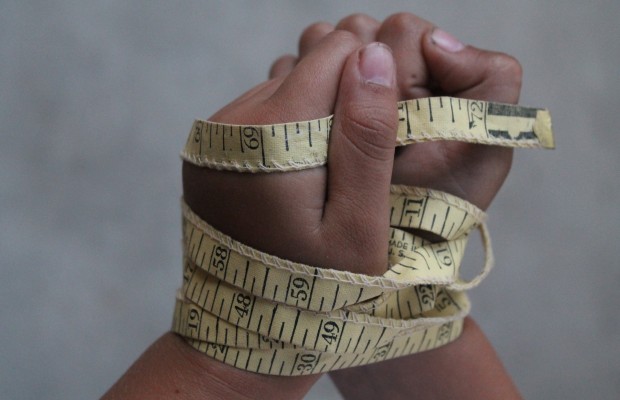Seeing, Stuffing, Starving

The Stigma and the Science
Over 24 million people in the US have an eating disorder, according to the National Association of Anorexia Nervosa and Associated Disorders. However, despite the sheer number of people affected by these disorders, there remain many misconceptions and incorrect assumptions surrounding their legitimacy as mental disorders.
Many people develop eating disorders because they are insecure about their appearance and their bodies. According to The Gale Encyclopedia of Science, someone with an eating disorder may feel like they have to appear a certain way to be accepted, or may feel the need to be able to control something in their life. An eating disorder can also result from a traumatic situation such as the death of a loved one, depression, or divorce. “Body image issues are usually an indication of a deeper problem,” said Madhavi Williams, high school psychologist.
The most well known eating disorders are anorexia nervosa and bulimia nervosa, commonly referred to as anorexia and bulimia. Anorexia causes one to have an almost uncontrollable desire to become increasingly thinner. Those afflicted with bulimia vomit after they binge eat to avoid gaining any weight and rid themselves of guilt. Both of these illnesses are incredibly dangerous due to the fact that those afflicted are robbing themselves of nutrition, and are keeping themselves from maintaining a balanced diet.
“The endocrine or hormone systems can be affected adversely,” said Lynn Baum, health teacher, said. “Nutrition also feeds the brain, enabling a person to think more clearly. If the person is starving the brain it can affect his or her feelings, behavior, academic achievement, and ability to manage stress.” According to Baum, not having enough nutrition can cause heart and brain damage, as well as many medical issues which could potentially lead to death.
In addition, those who develop eating disorders in their teen years have a higher risk of dying from them. Anywhere from 3.9% to 5% of teens afflicted with an eating disorder will die from it. “Their bodies have malnutrition and they are not getting enough nutrients to feed the body and the cells of the body,” Baum said. According to the NEDA (National Eating Disorder Association), anorexia is the most deadly mental disorder.
“If you’re looking at it from a self-conscious standpoint where they can’t stop themselves from (having an eating disorder), then it can be seen as more of a mental thing,” Patrick Harley, sophomore, said. “But I think otherwise it’s more of a physical problem than a mental one.”
These disorders are also often looked at as “not real” and end up as the punch line of jokes, making these illnesses seem less severe and offends those who have the illness.
“I don’t think it’s okay (for people to make jokes about eating disorders) at all. They should try to fit in their shoes and try to know what it feels like to have an issue that they can’t control and that’s wearing them down every day,” Emily Azma, junior, said. “It doesn’t help when people are making fun of them, which is just breaking them down even more. Everyone needs support if they’re going to try to get better.”
Treating eating disorders is difficult but not impossible. However, relapses during or after treatment are common. According to The Gale Encyclopedia of Science, in order for one to overcome an eating disorder, medication may be necessary, or even hospitalization in extreme cases. The first step to recovery for someone with an eating disorder is to tell a parent or trusted adult such as a school physiatrist about their disorder, no matter how difficult it may be. “It would be really important to have a support system that could listen to you, for one thing, and help you feel good about yourself,” William said.
If a student that has an eating disorder feels comfortable with telling their parent about the condition they are in, school psychologists, counselors, teachers and administrators are available for help. However, people often feel they have to keep their disorders secret because of the emotional pain tied to them.
“I’ve seen people go through it and I’ve seen the struggle and pain in their face that they don’t want to have it or go through that,” Azma said. ‘I think it’s easy to find help, but it may be tough in the process of getting help.”
A Constant Battle
“I was in fourth grade and I just hated the sound of my thighs rubbing together,” said Olivia Saad.
Saad, sophomore, has been struggling with body image issues since the age of nine. “In elementary school, I hated that all the other girls could fit their hands around their thighs and I couldn’t,” Saad said. Without being able to pinpoint the exact reason why she had insecurities about her thighs, Saad spent years concerned with her body image until she was recently diagnosed with Body Dysmorphic Disorder (BDD). BDD is a distinct mental disorder that causes a person to be preoccupied with an imagined physical defect that others often cannot see. “I have the beginnings of anorexia, but my main problem is BDD. It’s usually directed at one particular area, which for me is my thighs. And so people will see me one way, but when I look in the mirror and see myself, I see myself in a completely different way,” Saad said.
Like Saad, Emily Alahakoon, junior, has felt “unhappy about her weight” since childhood. As a kid, she always felt she was too skinny. However, as Alahakoon became older, she began associating being skinny with being beautiful and strived to be even more thin. Food became a touchy subject for Alahakoon as she directly associated it with her body image issues. According to Alahakoon, as a kid she would feel guilty about eating. “I always had this weird relationship with food,” Alahakoon said.
The more guilt that accumulated with eating, the more drastic her eating disorder became. “I was diagnosed with anorexia. I just didn’t really eat food,” Alahakoon said. “I was really good at fake-eating, like I would get a plate and put some crumbs on it and then leave it on the coffee table.”
For both Saad and Alahakoon, their eating disorders induced a guilt that made them resort to extreme measures. “Last year, I started skipping meals. I would throw away my lunches and would purposefully wake up late to skip breakfast because I didn’t think I needed it. And then every time I did eat, I would be really, really hungry. I would just binge eat and then just destroy myself internally,” Saad said. “I would be like, ‘I didn’t need that, I didn’t need to spend money on that food, I didn’t need to eat all that.’ I spiraled out of control.”
When it comes to confiding in friends and family, people struggling with eating disorders often have a difficult time finding people who know how to address the situation properly. However, if handled appropriately, telling trustworthy people can be beneficial. “A lot of the time when you’re suffering, it just consumes you so much to the point where it becomes second nature for you,” Saad said. “I told one of my friends and she kind of brought me back to the realization that this isn’t something that’s normal and that it wasn’t a healthy path that I was on.”
While some families understand that eating disorders are legitimate and are willing to help their children recover, not all families fully understand that eating disorders aren’t “just teenage angst.” According to Alahakoon, counselors eventually contact the families of students with eating disorders, and “depending on their situation that might not help.”
With regard to helping a person with an eating disorder, support is often the best way to do so. According to Alahakoon, most people with eating disorders don’t want to be bombarded with questions and forced to eat. “My friends all wanted to help me, but depending on how they went about it, sometimes it helped and sometimes it didn’t. A lot of times they would just try to force me to eat, and that’s not how it works,” Alahakoon said. “Just be there for them and don’t bring it up. A lot of times acting like it doesn’t exist helps because I would eat more in front of someone who didn’t know because that felt easier. You can talk in private about it, but it has to be the right time.”
Saad agrees. “Be a solid support system,” she said. “Because that’s really what they need since they’re just turning against themselves.”
After years of having an eating disorder and getting professional help, it is hard to “perfectly cure” someone who struggles with extreme body image issues. “I’m completely still in the process of recovery. I don’t know how far I’ve come but I know how far I want to go,” Saad said. “I can definitely say that I’m trying, which is honestly the best thing I can do at this point. I’m working towards finding a healthy balance, and I think that in itself is a big step.”
To those who are currently suffering or trying to overcome their past with eating disorders, both Saad and Alahakoon strongly recommend getting professional help. “If you have an eating disorder, definitely get help. I know that it feels like you can get over it by yourself as the only solution,” Saad said. “You feel like this is the path you have to go down, to reach the distorted version of skinny, but that’s not true. You have to try as hard you possibly can, even though it’s incredibly difficult, to pull yourself out of that and get help. You have to realize that the path you’re going down is not healthy and it’s not going to make you happy.”



